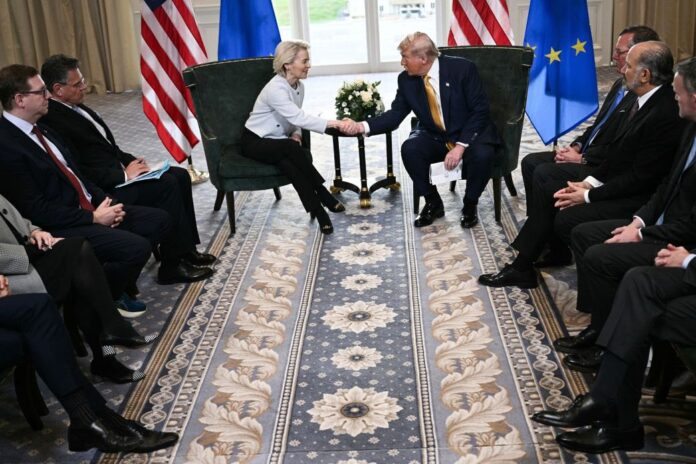
|
Getting your Trinity Audio player ready...
|
A Historic Deal Amid High Stakes
European and American negotiators have finalized a major transatlantic trade deal after months of tense back-and-forth. The agreement, struck in Scotland between U.S. President Donald Trump and European Commission President Ursula von der Leyen, imposes a 15% tariff on most EU exports to the U.S. — a sharp increase from the pre-2025 average of 2.5%.
While the deal averted a full-blown trade war, critics say Europe may have given up too much to maintain stability.
Markets Cheer, But At What Price?
European markets surged to four-month highs following the announcement. Shares of automakers spiked by as much as 3%, while broader EU indices reflected renewed investor confidence.
Key terms of the deal:
📦 15% tariff on most EU exports to the U.S.
💸 €514 billion in EU investment promised to the U.S.
Final tariff details on key sectors like wine, spirits, and semiconductors pending
Ursula von der Leyen called the agreement a step toward “stability” and “predictability,” even while acknowledging that 15% is a steep compromise.
German Chancellor Friedrich Merz described the deal as “disappointing,” stating, “I would have very much wished for further relief.”
EU Leaders Divided
The deal has provoked a political storm across the bloc:
🇭🇺 Hungarian PM Viktor Orban mocked the EU’s concessions, saying “Trump ate von der Leyen for breakfast.”
🇫🇷 French PM Francois Bayrou called it a “dark day” and a sign of “submission.”
🇪🇺 Former MEP Guy Verhofstadt labeled the agreement “scandalous” and “one-sided.”
🇩🇪 Bernd Lange, chair of the European Parliament’s trade committee, called it “lopsided.”

Analysts fear the EU’s lack of leverage, internal disunity, and failure to secure reciprocal U.S. concessions may set a dangerous precedent.
Winners and Losers
Who stands to benefit:
🚗 European carmakers could gain up to €4 billion due to lower vehicle tariffs
📉 Investors welcomed the reduced trade uncertainty
🏦 Markets avoided the shock of retaliatory trade wars
Who bears the burden:
🇩🇪 German manufacturers, facing an estimated €6.5 billion in new export costs
🏭 Export-heavy sectors like chemicals, steel, and luxury goods
📉 Long-term EU competitiveness in U.S. markets
Melanie Vogelbach of the German Chamber of Commerce noted, “This deal makes our exports far less competitive than U.S. production.”

Averted Trade War, But At What Strategic Cost?
Brussels narrowly avoided a wider economic conflict. The EU had prepared €72 billion in retaliatory tariffs and was considering tough restrictions on American tech and finance, but those threats were withdrawn early — a move some say undermined their negotiating position.
With over €647 billion in EU energy purchases and investment commitments to the U.S. on the table, many economists are skeptical.
“That’s a huge promise with unclear feasibility,” said UC Berkeley economist Allan Auerbach.
What Happens Next?
The deal is not yet finalized:
✍️ A full legal draft is expected in the coming weeks
🏛️ Requires approval from all 27 EU member states and the European Parliament
⚖️ Trump’s authority to impose unilateral tariffs is being challenged in multiple lawsuits — any ruling against him could derail the deal
Meanwhile, Brussels continues to push for:
🍷 Exemptions for European wine and spirits
💊 Relief on pharmaceuticals and semiconductors
🔄 Reduction of non-tariff barriers such as VAT and regulatory red tape
While the EU managed to avoid economic disaster, many see the deal as a strategic retreat. Whether this pact brings lasting trade stability — or sets a troubling precedent for future negotiations — remains to be seen.
📢 What do you think?
Was this a smart deal or a surrender? Share your thoughts in the comments below.
🔁 Follow Danchima Media on X for real-time updates on global trade and geopolitics.
